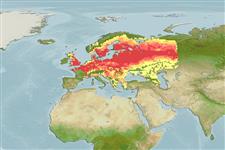Classificação / Names
Common names from other countries
Referência principal
Tamanho / Peso / Idade
Max length : 64.0 cm TL macho/indeterminado; (Ref. 6114); common length : 15.0 cm TL macho/indeterminado; (Ref. 556); Peso máx. publicado: 3.0 kg (Ref. 556); Idade máx. registada: 10 anos (Ref. 59043)
Ambiente
; Água doce; estuarina demersal; potamódromo (Ref. 51243); intervalo de profundidade 5 - ? m (Ref. 2163)
Clima / Intervalo
Temperate; 2°C - 22°C (Ref. 1672), preferred ?; 69°N - 35°N, 10°W - 169°E
Distribuição
Eurasia: North, Baltic, White, Barents, Black and Caspian Sea basins; Aegean Sea basin only in Maritza drainage; eastward to Kolyma drainage (Siberia); westward to Rhine and eastern drainages of England. Absent from North Sea basin in Sweden and Norway. In Baltic basin north to about 66°N. Widely introduced to Italy, England and France but possibly often confused with Carassius gibelio (Ref. 59043). At least one country reports adverse ecological impact after introduction.
Países | Áreas FAO | Ecossistemas | Ocorrências | Introduções
Descrição breve
Espinhos dorsais (total): 3 - 4; Raios dorsais moles (total): 13-22; Espinhos anais 2-3; Raios anais moles: 5 - 7; Vértebras: 32. Diagnosed from its congeners in Europe by having the following characters: body golden-green shining color; last simple anal and dorsal rays weakly serrated; 23-33 gill rakers; lateral line with 31-36 scales; free edge of dorsal convex; anal fin usually with 6½ branched rays; and peritoneum white (Ref. 59043). Caudal fin with 18-20 rays (Ref. 2196). No barbels. The third dorsal and anal-fin rays are strong and serrated posteriorly.
Categoria na Lista Vermelha da IUCN (Ref. 115185)
Ameaça para o homem
Potential pest (Ref. 13686)
Utilização humana
Pescarias: altamente comercial; Aquacultura: espécies comerciais; peixe desportivo: sim; Aquário: Espécies comerciais; isco: occasionally
Mais informação
ColaboradoresFotografiasStamps, CoinsSonsCiguateraVelocidadeTipo de nataçãoÁrea branquialOutras referênciasCérebrosVisão
Ferramentas
Relatórios especiais
Descarregue XML
Fontes da internet
Estimates of some properties based on models
Phylogenetic diversity index
PD50 = 0.5312 many relatives (e.g. carps) 0.5 - 2.0 few relatives (e.g. lungfishes)
Nível Trófico
3.1 ±0.24 se; Based on food items.
Resiliência
Médio, tempo mínimo de duplicação da população 1,4 - 4,4 anos (tm=2)
Vulnerabilidade
Moderate vulnerability (38 of 100)
Categoria de preço
